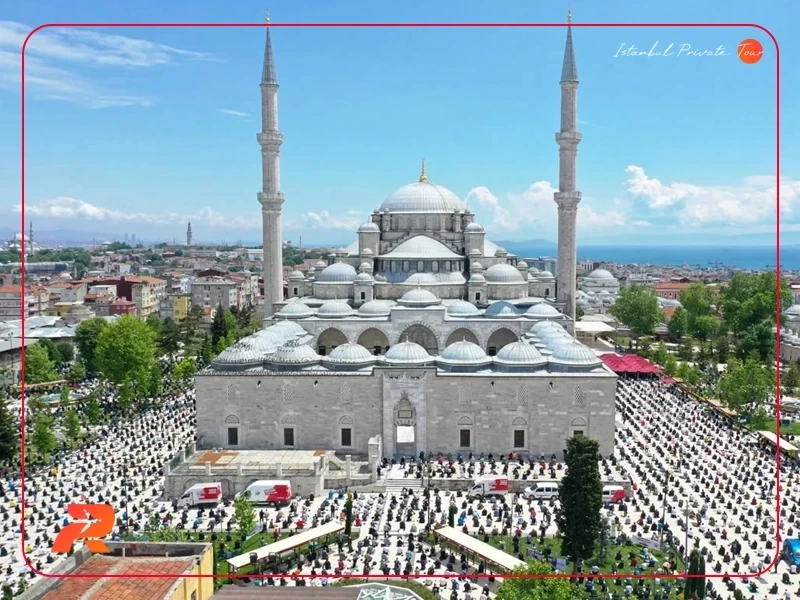The Fatih Mosque in Istanbul

Nestled in the heart of Istanbul, Turkey, stands the Fatih Mosque. This architectural marvel is a testament to the city's rich history and cultural heritage.
Constructed between 1463 and 1470, the Fatih Mosque is a symbol of the Ottoman Empire's grandeur. It was built under the orders of Sultan Mehmed the Conqueror, after whom the district of Fatih is named.
The mosque's design is a stunning example of Ottoman architecture. Its grand dome, towering minarets, and intricate decorations reflect a blend of Byzantine and Ottoman design elements.
But the Fatih Mosque is more than just an architectural masterpiece. It has served as a center of Islamic learning and a hub for the local community for centuries.
Today, the mosque continues to be an active place of worship. It also attracts tourists from around the world, drawn by its historical significance and architectural beauty.
Join us as we explore the amazing Fatih Mosque. We will look at its history, design, and lasting charm.
The Historical Significance of Fatih Mosque
The Fatih Mosque is not only an architectural gem but also a historical landmark. Built shortly after the Ottoman conquest of Constantinople, it symbolizes the Ottoman Empire's rise and establishment.
Initiated by Sultan Mehmed II, the mosque stands as a tribute to the conqueror's architectural vision. It was crafted to reflect the grandeur of the new capital, blending monumental design with spiritual significance.
Throughout history, the Fatih Mosque has endured the tests of time. Though damaged by earthquakes, it was lovingly restored, preserving its original charm. It embodies the resilience and cultural richness of Istanbul, continuing to captivate visitors today.
Architectural Splendor of Fatih Mosque
The architectural beauty of the Fatih Mosque attracts both admirers of design and history. It exemplifies the transition from Seljuk to Ottoman architectural preferences. This transition is visible in its harmonious blend of Byzantine and Ottoman styles.
The mosque's structure is a masterpiece with its harmonious proportions and detailed craftsmanship. Its design incorporates large courtyards, offering spaces for prayer and reflection. The courtyards are spacious, enhancing the mosque's grandeur.
The mosque is part of a broader complex, showcasing early Ottoman urban planning. This complex includes facilities like a hospital, library, and kitchen, emphasizing the mosque's social importance. These facilities were integral to providing essential services to the community.
A classic example of Ottoman architecture, Fatih Mosque has influenced numerous structures throughout the empire. Its architectural elements, such as domes and intricate decorations, set a standard for later designs. Its legacy is cherished by architects and historians worldwide.
The Grand Design: Domes and Minarets
The Fatih Mosque's dome is an iconic feature, a marvel of engineering and aesthetics. It spans an impressive 26 meters, supported by four massive pillars, a testament to Ottoman skill.
Equally striking are the mosque's towering minarets, each over 70 meters high. These minarets accentuate the mosque's verticality and grandeur, reaching towards the sky. They form a vital element of the mosque’s silhouette against the Istanbul skyline.
Interior Wonders: Calligraphy and Ornamentation
Inside, the Fatih Mosque reveals an abundance of intricate calligraphy and decoration. These elements are thoughtfully crafted, reflecting the artistic devotion of the era.
The mosque's interiors are bathed in light from numerous windows, creating a serene ambiance. This illumination highlights the ornamental motifs, emphasizing the mosque's grandeur. Each detail resonates with the rich tradition of Islamic art.
Fatih Mosque: A Center of Learning and Charity
The Fatih Mosque complex stands not only as a place of worship but also as a hub of education and charity. Its foundation was laid with the vision to serve both spiritual and worldly needs of the community.
Historically, the complex included a medrese, an Islamic school, contributing to Istanbul's scholarly life. This tradition of learning was supported by social services like a hospital and a soup kitchen. This shows the Ottoman focus on helping the community. These elements underscore the mosque's pivotal role in society.
The Mosque Complex: More Than Just a Place of Worship
Beyond the prayer halls, the Fatih Mosque complex was designed to be a self-sufficient community center. It encompassed various facilities that catered to the daily needs of locals and travelers alike.
The complex had a busy market and a hammam, or Turkish bath. This made it an important place for the community to gather. Such amenities were vital in the historical fabric of Istanbul, cementing the mosque's role beyond religious functions.
Visiting Fatih Mosque: Tips and Insights
Visiting the Fatih Mosque in Istanbul offers a unique glimpse into the rich tapestry of Ottoman history and architecture. To enjoy your visit, explore the area around you. It has local markets and traditional restaurants.
It’s wise to dress modestly when visiting this active place of worship. As you wander through the mosque complex, take time to enjoy the serene garden and the panoramic city views. These elements combine to provide a peaceful contrast to the bustling streets of Istanbul.
How to Get There: Accessibility and Transport
Getting to the Fatih Mosque is quite straightforward. It is easily accessible by Istanbul's efficient public transport system. Visitors can take a metro or a bus to the Fatih district, followed by a short walk.
Best Times to Visit and What to Expect
To avoid the crowds, visiting early in the morning is advisable. Expect a serene atmosphere inside the mosque, with the opportunity to admire its intricate details and historic charm undisturbed.
The Fatih Mosque Today: A Living Legacy
Today, Fatih Mosque stands as a testament to Istanbul's enduring history and cultural vitality. Despite centuries of transformation, it remains a thriving center for worship and learning. Its continuous role throughout history showcases its resilience and significance.
The mosque attracts not only worshippers but also countless visitors intrigued by its architectural allure. Its influence extends beyond religious purposes, standing as an emblem of the rich Ottoman heritage. This historical monument amazes visitors. It offers a look into the past while still thriving today.
Community and Culture: The Mosque's Role in Modern Istanbul
In modern Istanbul, Fatih Mosque is more than just a spiritual haven; it's a community cornerstone. It fosters unity among locals who gather for prayer and celebrations, strengthening community bonds.
The mosque's presence also enriches the cultural landscape of Istanbul. It frequently hosts cultural events and educational programs, serving as a bridge between past traditions and contemporary life. The Fatih Mosque is an important part of the city. It connects history, culture, and community.
The Enduring Appeal of Fatih Mosque
The Fatih Mosque captivates visitors with its profound history and architectural splendor. It stands as a beacon of Istanbul's rich cultural heritage, drawing travelers and worshippers alike. Its majestic beauty and historical significance ensure its place as a cherished landmark for generations to come.
Similar Posts

Uzungol Lake in Turkey
Explore Uzungol Lake in Trabzon, Turkey, with its enchanting views, green forests, fishing adventures, camping, and tourist activities.

Discover Mersin City
This article highlights the significant advantages of Mersin, geographically and economically, and its potential for ongoing real estate development.


